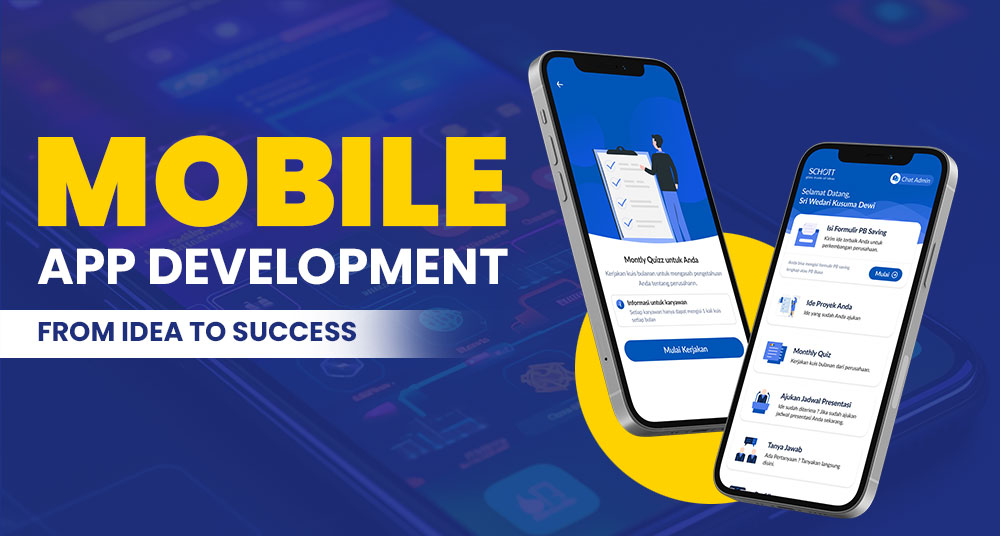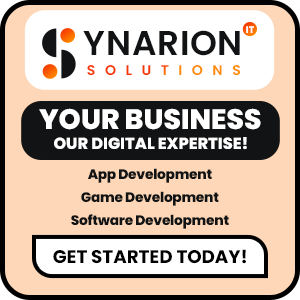What is Mobile App Development?
Mobile app development is an act or process of creating applications for various mobile devices like Android, iOS, tablets, etc. The use of the internet and the interest of users make this development industry so popular globally. According to a 2023 report, 60% of consumers prefer mobile shopping apps over mobile sites. 88% of consumers have at least one shopping app on their phone.
Types of Mobile Applications
Progressive Web/Mobile Apps
A progressive web app (PWA) is a type of web app that gives a similar experience on web and mobile devices. PWA is the best choice for news and media companies to serve great mobile & web experiences to their users.
Example of some Progressive Web Applications
- Starbucks
- BMW
- MakeMyTrip
- Uber
- Spotify
Why do these Successful business entities choose PWA?
Successful business ventures like Starbucks, BMW, Flipboard, MakeMyTrip, Uber, Pinterest, and Spotify choose Progressive Web Apps (PWAs) for enhanced user experiences. PWAs offer fast loading, offline capabilities, and seamless performance, providing these brands with a competitive edge in delivering optimal services to their users. Embracing PWA technology has become a strategic choice for improving engagement and accessibility in the digital landscape.
Native Applications
A native app is an app that is made for one particular operating system (e.g… iOS or Android) only. The Native apps are made with a specific programming language only. These kinds of apps are downloadable from specific app stores. Most of the community businesses choose to build native applications because that kind of app wants to establish their brand value by serving better connectivity.
Examples of some Native Applications
- Twitter/X
- Hive
- Mint
- SoundCloud
- Walmart
Why do Businesses Choose Native Applications?
Businesses opt for native applications due to their seamless integration with specific platforms, ensuring optimal performance, responsiveness, and a tailored user experience. Native apps leverage the full potential of device capabilities, offering enhanced functionality and speed. The ability to access platform-specific features, robust performance, and superior user engagement are compelling reasons for businesses to choose native applications, delivering a competitive edge and satisfying user expectations.
Hybrid Applications
Apps that are built with hybrid technology support multiple platforms. The hybrid apps combine both native and web application elements. Hybrid app development is beneficial for businesses, especially startups who don’t have much budget for app development.
Example of some Hybrid Applications
- Evernote
- Discord
- NerdWallet
- Travelstart
- Microsoft Teams
- Evernote
Why Native App Development is the First Choice for Startups?
Native app development remains the top choice for startups due to its unmatched performance, seamless integration with device features, and optimal user experience. Building natively allows startups to leverage platform-specific capabilities, ensuring faster performance and better responsiveness. With the ability to tap into the full potential of iOS and Android platforms, native development provides a solid foundation for startups aiming to deliver high-quality, intuitive mobile applications that stand out in the competitive market.
Mobile App Development Process [6 Key Steps]
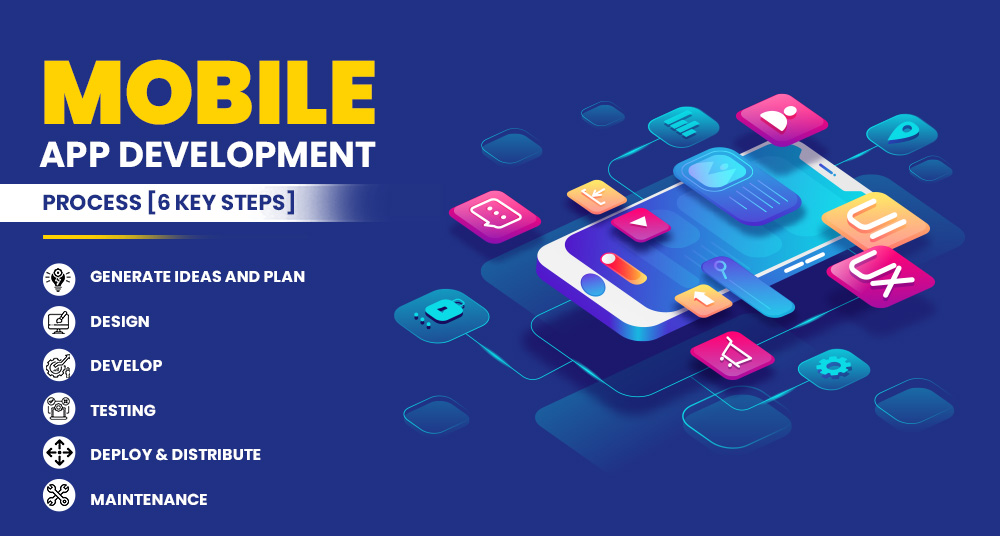
Generate Ideas and Plan
The inception of a great mobile app begins with a compelling idea. This phase involves brainstorming, market research, and understanding user needs. Identify the purpose of your app, target audience, and unique selling points. A well-defined plan outlines the app’s features, functionality, and technical requirements. Consider the platform (iOS, Android, or both), technology stack, and monetization strategy. The clearer the plan, the smoother the development process.
Design
The design stage is very important for creating an engaging and user-friendly interface. Start with wireframes to visualize the app’s structure and flow. User experience (UX) and user interface (UI) design play pivotal roles in attracting and retaining users. Pay attention to color schemes, navigation, and overall aesthetics. Prototyping allows for testing the design before development begins. Collaborate closely with designers and gather feedback to refine the visual elements.
Develop
Once the design is finalized, the development process begins. Developers use the chosen programming languages and frameworks to bring the app to life. For native apps, Objective-C or Swift for iOS and Java or Kotlin for Android are common choices. Cross-platform app development can be achieved using frameworks like React Native or Flutter. Regular communication between designers and developers is essential to ensure the design vision is translated into functional code.
Test and QA
Testing is a critical step to identify and rectify bugs, ensuring a smooth user experience. Quality Assurance (QA) encompasses various types of testing, including functional, performance, security, and usability testing. Testing should cover different devices, screen sizes, and operating system versions to guarantee compatibility. Automated testing tools can enhance efficiency, but manual testing is equally important. Rigorous testing reduces the likelihood of post-launch issues and enhances the overall app quality.
Deploy and Distribute
With the app development and testing phases complete, it’s time to deploy the app to the respective app stores. For iOS devices, this means the Apple App Store, and for Android devices, it’s the Google Play Store. Follow each platform’s guidelines and submission process. App listing involves creating developer accounts, preparing promotional materials, and adhering to specific requirements. The deployment process may include beta testing to gather user feedback before the official launch.
Maintain and Update
Post-launch, the journey doesn’t end; it enters a phase of maintenance and updates. User feedback and performance metrics should be regularly monitored. Address any emerging issues promptly and release updates to introduce new features, improve functionality, and fix bugs. Stay abreast of technological advancements and operating system updates to ensure the app remains compatible and secure. Continuous improvement is key to sustaining user engagement and app relevance.
Market Winning Strategies for Your Newly Launched Application
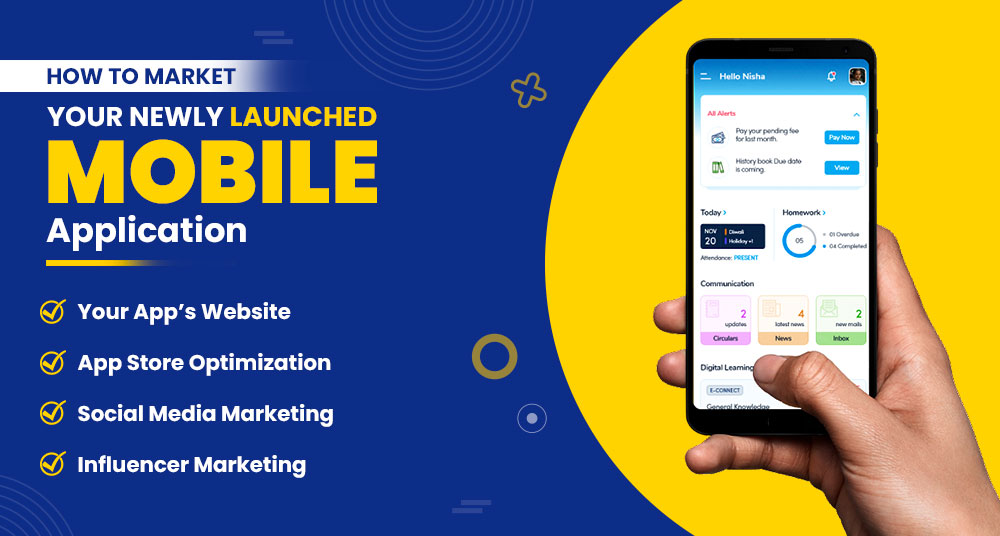
Your App’s Website
This is your app’s introduction to the world. Having a website for your app is an essential part of marketing because with the help of a website you can provide detailed information to your audience about the application. To do keyword research, and competitor research for the SEO of your website you can use a few tools like SEM Rush, Ahrefs, UberSuggest, BuzzSumo and SPYFU.
Landing Page
When setting up your app’s landing page it’s vital to offer an appealing and accurate visualization of what users expect when they install the app.
- Add screenshots & videos
- Create appealing banner
- Add download button
- Run a loyalty program
- Add social proof
- Get user feedback from reviews
Blog
This is also another way you can use keywords to reach your target audience with keyword stuffing on your landing page. Use an effective silo structure for getting quality traffic to your website. And remember one thing please you should avoid keyword stuffing otherwise google mark your content under a poor category and drop your rank from the SERP.
Here are examples of some industry app development blogs of your interest: grocery delivery, fantasy sports, taxi booking and real estate app development.
App Store Optimization
App store optimization is the organic way that helps you to increase your app installs in the respective app store. It’s similar to SEO, but with ASO we increase downloads and with SEO effort WE increase organic clicks on our website.
Best ASO Techniques:
App Name
App name is considered as a title/h1 in the app store. So be clear while optimizing your app name.
App Icon/Screenshots
App media is an essential part of ASO. Because those give hints to the users what is the use of your application.
Promo video
The Promo video is a brief summary of your application. This showcases the features and functionality of your respective app.
App description
As we know “content is the king” So you should need to write an engaging and relevant meta description including relevant keywords.
Learn how to increase your app installs with following the ASO Guide.
Social media marketing
Social media marketing is a way to promote your business globally through creating engaging content in the form of:
- Post
- Reel
- Live
- Offers
- Paid Partnerships
- Brand collab
To know more about social media marketing follow our SMM Guide.
Influencer marketing
The vast majority of consumers (86%) said authenticity is important when deciding what brands, they like and support. Influencer marketing is the most effective marketing strategy nowadays because, in this kind of marketing tactic, a content creator who has a strong engaged audience base promotes your application and makes its brand identity. In a recent survey, it was found that the influencer Marketing Industry to reach nearly $21.1B or more by the year 2023.
2024’s languages to build a User-Centric Best mobile app development
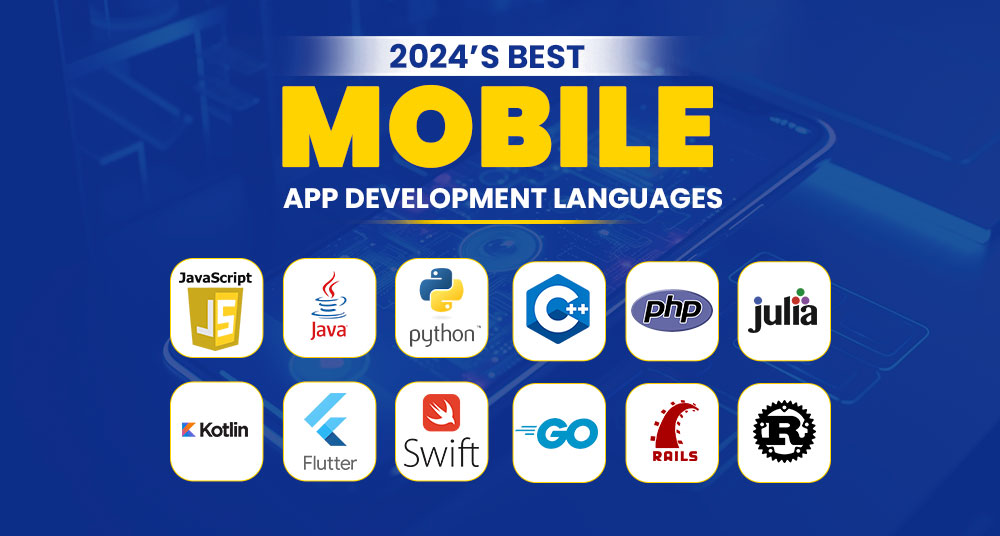
Java Script
Widely used for web and mobile app development, JS offers versatility and interactivity, making it a cornerstone for dynamic interfaces.
JAVA
A robust, cross-platform language, Java remains a stalwart for Android app development, ensuring scalability and performance.
Python
Known for its readability and simplicity, Python is favored for rapid development, AI, and data science applications.
Kotlin
As the official language for Android development, Kotlin boasts concise syntax and seamless interoperability with Java.
Flutter
This is an open-source mobile app development framework created by Google. It helps you create high-quality, fast and beautiful apps for your business.
Swift
This is a powerful programming language that helps you in creating iOS applications with great functionality.
C/C++
Renowned for performance-critical applications, C/C++ underpins system-level programming and game development.
PHP
A server-side scripting language, PHP is instrumental in web development, offering dynamic content and database connectivity.
Julia
Geared towards scientific computing, Julia excels in numerical and data-intensive computations.
Go (Golang)
Developed by Google, Go focuses on simplicity and efficiency, making it ideal for scalable and concurrent systems.
Ruby on Rails
A robust framework for web development, Ruby on Rails emphasizes convention over configuration, enhancing productivity.
Rust
Known for memory safety and performance, Rust is gaining popularity in system-level programming, ensuring secure and efficient code.
Final Thoughts
In the online competitive business world, mobile app development success lies in a strategic journey – plan, design, develop, test, deploy, launch, and market. Understanding these stages ensures a seamless and impactful app experience. Embrace innovation, user-centric design, and robust testing for a successful deployment. Finally, a well-executed launch backed by effective marketing strategies completes the cycle, driving user adoption and ensuring sustained success in the competitive app landscape.




